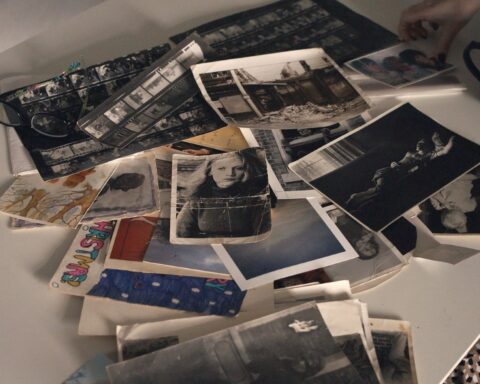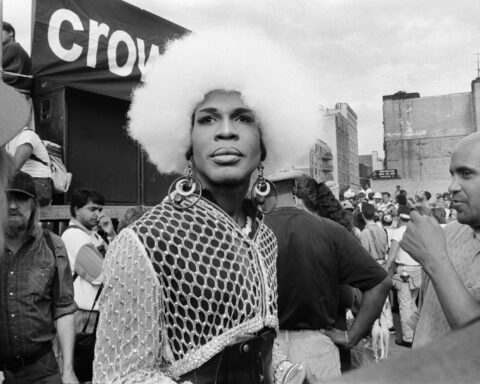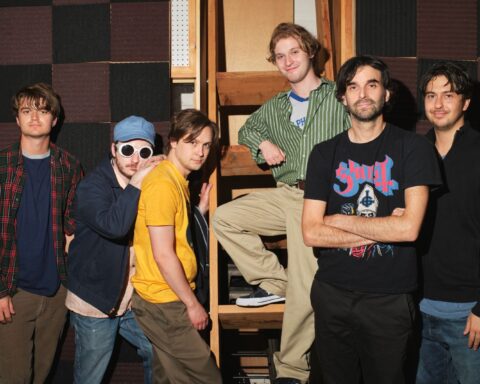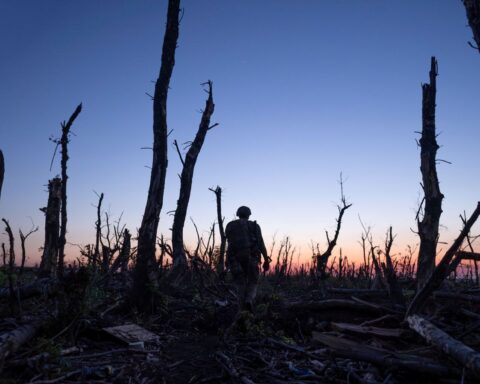Alec Soth has made a remarkably swift rise to prominence in the art photography world. His first major project, photographs of people and places on the Mississippi River, resulted in gallery shows in New York and San Francisco in 2004. As part of the same project, the eminent publisher Steidl produced the brilliantly designed book Sleeping by the Mississippi. Soth joined the internationally renowned photo agency Magnum that year, too—and one of his photos of a man in a flight suit holding two model aeroplanes was the poster image for the Whitney Biennial.
By 2006, when Steidl published his second major project Niagara, Soth had become part of the distinguished stable of artists at the Gagosian Galleries. Like Sleeping by the Mississippi, Niagara is a bittersweet look at the people inhabiting—if only briefly—one of America’s legendary locales. The contrast between the fragility of his subjects and the mythical nature of the environments that surround them render his photos provocative and ambiguous. Questions about his humanistic regard for his subjects were raised again in Broken Manual, a four-year investigation into hermits and iconoclasts, outsiders living outside of societal restraints in forests and wilderness areas in America. While it’s obvious that Soth spent time getting to know the remarkable—and remarkably strange—individuals in the book, his attitude towards them isn’t entirely clear. The photos, as always, are beautiful, emphasizing the lush, pictorial aspects of the subjects, both human and natural.
Later in 2010, after the publication of Broken Manual, the Walker Art Center in Soth’s home state of Minnesota produced a major retrospective of his work and published an accompanying volume, From Here to There: Alec Soth’s America. Eminent art critics and curators Geoff Dyer, Britt Salvesen and Barry Schwabsky weighed in on his embrace of Americana—from road trips to trips up the aisle—and his perceptive approach to such character archetypes as Southern gothic dreamers, outsiders and newlyweds. In 2015, Songbook, published by MACK books, accompanied a touring show of Soth’s recent voyages investigating America’s decaying communities, this time highlighted by classic American tunes, which offer a poetic, ironic response to the photos.
Besides creating and photographing these major projects, Soth has made numerous magazine shoots and contributed to a number of books and gallery shows. Remarkably, he has found the time and energy to start his own publishing and blogging—and now workshop—enterprise, Little Brown Mushroom. Soth has not only produced smaller self-made projects there, he has also published works by colleagues and friends.
Last fall, Gathered Leaves, the largest retrospective of Soth’s work ever to appear in Europe was created at London’s Media Space in the city’s Science Museum. I was fortunate enough to see the show, which covered all of Soth’s major projects as well as some of his Little Brown Mushroom blogs and zines. Through the chronology of his work, it showed how his singular vision has deepened over the past decade and a half. Soth and the Gathered Leaves show were widely reviewed; a typically laudatory critique came from Sean O’Hagan, photography critic at the U.K. Guardian: “this thoughtful retrospective is conclusive proof that he is the most important visual chronicler of the U.S. at work today.”
POV’s editor Marc Glassman spoke to Alec Soth on the phone in Minnesota, where he is curating a show of his dream-like work for Toronto’s CONTACT festival.
POV: Marc Glassman
AS: Alec Soth
POV: Please tell me about your show at CONTACT, Alec.
AS: I have an idea to look at my work from a 20-year standpoint. I feel like I’m looking at it through a different lens now. The thing I like about photography that’s different from filmmaking or other art forms is that it is a fragmentary medium. You can re-shuffle it in different ways. I’m using the connecting line of sleep and dreams, and how that runs through all my work. A peculiar thing about my trajectory as a photographer is that since I entered Magnum Photos, there’s this appearance of me being a documentary photographer. I totally understand that because my work looks documentary, but it’s always had this surrealist undercurrent.
POV: Yes, I see that. Your choice of projects is certainly subjective although many of the images can be read as being documentary. But going back to your first major project Sleeping by the Mississippi, it’s also been about dreams, hasn’t it?
AS: Yes, and there it is in the title, which was an intentional act to say that this is not some sort of definitive documentation of the Mississippi River, but these pictures are connected by a kind of stream-of-consciousness thinking.
POV: I love it. A stream of consciousness—it’s a different kind of river.
AS: Exactly. And, in fact, that project was originally called From Here to There, with one picture leading to the next, but then I decided to make it look more documentary. There’s this great quote about Cartier-Bresson, who started off as a surrealist but became known for documentary photography. When they were starting Magnum after the Second World War, Robert Capa famously said to him, “Don’t keep the label of a surrealist photographer. Be a photojournalist. If not you will fall into mannerism. Keep surrealism in your little heart, my dear. Don’t fidget. Get moving!” I came to believe that, and I still do believe that in a lot of ways. I like riding that line between one tendency and the other, and with this exhibition the idea is to expose it more directly.
POV: So what kind of photos will you be showing—will there be some things that I might recognise from other projects you’ve done?
AS: Yes, I try to throw in a picture from each major project. Gathered Leaves is what I think of as a major project, as well as Sleeping by the Mississippi, Niagara, Broken Manual and Songbook, and there is one image at least from each of those, but then there’s all sorts of other material. And that’s the other thing—I’m a big project photographer, but I do all these other small projects. Things that don’t get seen, but which are essential to my process, will be included in the show—photos that I’m printing for the first time. You’ll see really early work from before Sleeping by the Mississippi to stuff that I produced a month and a half ago.
Broken Manual from Little Brown Mushroom on Vimeo.
POV: I’m curious about your publishing company and new media site, Little Brown Mushroom. You’re able to publish not only your smaller projects but also other people’s work that you like. Can you tell me about that?
AS: I gave a lecture in Birmingham, England recently and was asked, “How do you keep from getting stale as a photographer?” My answer is Little Brown Mushroom. It’s a kind of sandbox, where I get to play and experiment. There are lower stakes and I get to learn all sorts of new stuff. I’ve moved away from publishing right now and am doing educational workshops, which I don’t totally understand, and I’m figuring it out—getting scared, getting lost and trying out ideas. And that relates to the show as well, where I’m presenting work in a way that I’ve never presented it before, and that’s definitely what Little Brown Mushroom is about.
POV: I know you’ve always been interested in narrative and that Wim Wenders was an early inspiration for you. One of your small projects for the compilation The Image to Come was on old movie theatres, with Wenders’ Kings of the Road and Paris, Texas as the starting point. Can you talk about your different approaches to the road trip from the point of view of being a photographer and the qualities of photography that are different from what you would see in a film?
AS: This issue is sort of my obsession as a photographer because of my inability to crack the nut of it. I believe that storytelling is so profoundly gratifying. I’ve had those moments, and a couple of them have been with seeing Wim Wenders’ films as a young, up-and-coming artist, and just being impressed by the power of the narrative form. Photography just doesn’t quite do that, because it’s more fragmentary. It leaves wide-open spaces between the pictures for the viewer to create their own connections. The interesting thing about filmmakers like Wenders, and the fact that he is a photographer himself, is that he’s on that spectrum too, where he’s desiring to leave spaces open. It’s just a matter of how much one does it. I really learned about this while making Broken Manual, because I had filmmakers [Laure Flammarion and Arnaud Uyttenhove] following me around, and it was great because I knew that they were connecting the dots in a more linear way with their film Somewhere to Disappear, and that left me more open to be fragmentary. I think there’s a spectrum of narrative to non-narrative, and with different projects and ways of re-shuffling pictures, I can move in different places on that spectrum. One thing I’ve learned is that when I push way too far in the narrative form, I tend to fail, because I’m not a filmmaker, and I just don’t think that way.
POV: I’ve read Broken Manual, and it was fascinating to see the selections for the Gathered Leaves show. It’s far different following the trajectory of a curated programme of photos on four walls in a room from reading a book, where your intentions are clear, page by page. In both cases, though, I found a kind of tragic quality to these people—outsiders, who you got to know really well. I started to imagine who they were, what their inner lives are like.
AS: To your point about the story aspect of Broken Manual, that is the goal of all of my photography. My belief in photography is that it doesn’t tell a story; it suggests a story, and then the viewer can run with that. The way I experienced making Broken Manual and the story that I take from it is that the desire to run away is dysfunctional—you can’t—and there’s a real sadness to this desire to self-sufficiency and its inevitable failure. When I approach someone who’s had that state of mind, they’re generally hungry for the attention, which itself shows the failure of that desire. And the fact that I’m making this work while not being alone myself—I mean, I have this desire to make work myself, but at the same time I want this film crew to follow me around, and I want to share what I do with other people. It’s just rich with irony.
POV: It just occurred to me that maybe one of your surrealist images could be the disco ball in the forest.
AS: Absolutely. I think that one might be in the show. It’s been in and out. It’s a very dreamlike picture, but a real moment; it’s not fabricated.
POV: If there’s a stereotype about Canada it’s that we’re not people with a grand vision; we don’t write epics. One of the things I love about the States is its tendency to think in epic terms, and I think about the major books that you’ve done — Mississippi, Niagara, Broken Manual, Songbook and From Here to There, which is subtitled “Alec Soth’s America”—as part of that tradition. How do you feel about that?
AS: Well first of all, I’m Minnesotan. I’m half-Canadian, practically [laughs]. In spirit too—Minnesotans and their modesty—I think we’re linked, in a way.
POV: But they are major statements, aren’t they?
AS: Yeah. And I’ve always been slightly embarrassed about that. Less with Niagara, but much more with Mississippi. I just found that kind of embarrassing—the scope of the river suggests Mark Twain—so you pointing that out I find embarrassing, which I think is kind of Minnesotan, to feel embarrassed, so I understand your Canadian-ness.
POV: I find that you are observing something that even I as a Canadian see as very interesting about America—the Faulkner or Hemingway approach, the larger context.
AS: It’s true. I always talk about photography as a language, and I had this revelation recently, when I gave a lecture in Tokyo. It had to be simultaneously translated, and when something like that happens, you just realise how hard language can be. Pictures don’t really translate. Maybe they do on one level—so in some ways photography is an international language—but really, it’s all wrapped up in certain dialects. So photography has these different languages, or different dialects, and I’m very aware that I speak an American dialect of photography. In my formative years, it was so much of that hardcore American MoMA/Yale trajectory of photography, which is big American photography. So I grew up on that, but at the same time I had this other strain of it, which is this kind of middle-American sensibility. I was raised on the big American photography you’re asking about, but I do have, I think, a middle-American sensibility, which is slightly different. I know that’s a super-nuanced response, but I feel it.
AS: I asked Martin Parr one time—we were talking about lectures and the questions that we get—and he said the number one question he gets is about photographing strangers, and I thought that was strange that he would get that, because it’s certainly my number-one question. There’s just a lot of apprehension, and I think a lot of it comes from the fact that people drawn to photography as an art-form are very often on the more solitary side of things, as I was. The reason I fell in love with photography was that I liked Robert Adam’s Summer Nights, Walking, and I wanted to wander around at night alone, and then you realise, “Oh, man, I really love Arbus,” or whoever it is, and you really want to learn how to do what she did with people, and it’s terrifying. It certainly was for me. And then it just became a kind of exposure therapy, like, “I’m afraid of heights, so I’m going to go skydiving.” And I just kept skydiving. I kind of thrive on it, creatively, although I still sort of don’t like it. I don’t like approaching people. I never talk to the person in the seat next to me on the airplane. I’m not that person. I really admire people that are, but it’s not me. So it’s weird that I made a life out of this—really weird.
POV: So when you’ve got a project that you’re really interested in, and you realise that you really have to talk to people to accomplish it, do you just develop a different mindset at that point and go ahead and do it?
AS: Yeah, it’s a different mindset. And now I’ve done it so much, I can just grab my camera and put on my photography jacket, and go do it. It’s part of the job. I love it when I’m doing it, in a way, but
It’s not natural to me.
POV: You have created a number of acclaimed photo books. Everyone always talks about The Americans as an inspiration but are there any new ones that you’ve admired in the recent times?
AS: I was raised on American-style photography, and it’s like if you’re a music fan and you really loved REM when you were coming up— it’s not like I sit there and listen to them all day now. I don’t pore through Stephen Shore books all day. That’s in me, because I fell in love with it when I was young, but it’s not the thing that gets me super excited now. I get exposed to all kinds of material from all over the world, and enjoy them but in a different way. Rasen Kaigan by Lieko Shiga is a recent Japanese photo book I love; it has endless revelations, and things that I can learn from. I’m never going to be a Japanese photographer or a Dutch designer but I enjoy and learn from seeing what they do. But I feel that the longer you do something, the more you’re drawing on your own history. I incorporate little bits of stuff here and there from photography, and obviously from other media as well, but it just becomes this conversation with myself, which may sound a bit narcissistic.
POV: You’re editing your own photos to create this project for CONTACT. Can you talk about that process?
AS: It’s fascinating. As time goes by, and you’re having this conversation with yourself, you can draw on older work, which you can see it in a new way. You can see it with fresh eyes and more sophisticated eyes, which can be better or worse. When I made the book Looking for Love in 1996—which was never called Looking for Love when I made it—it could never have been edited that way. And so now when I go and I start digging around through old pictures, I see photos that I like that I never would have liked then. And that’s great—it’s like a treasure trove; I love it. This show is all about getting to do that, and making connections between things that I’ve made over the years that I didn’t know were connected at the time.
POV: Reconfiguring the narrative.
AS: Yes, exactly.
Alec Soth: Songbook from Fraenkel Gallery on Vimeo.











